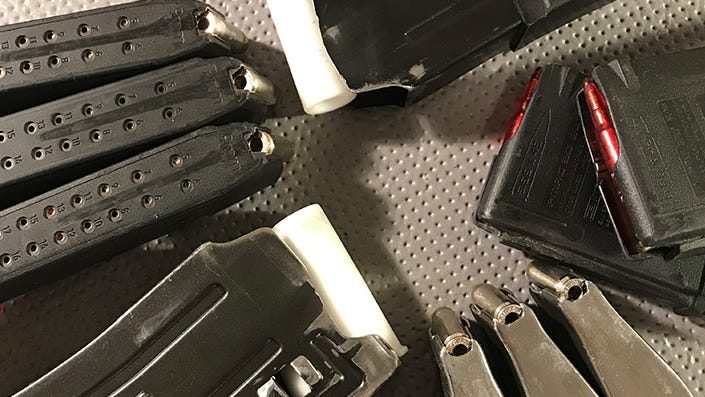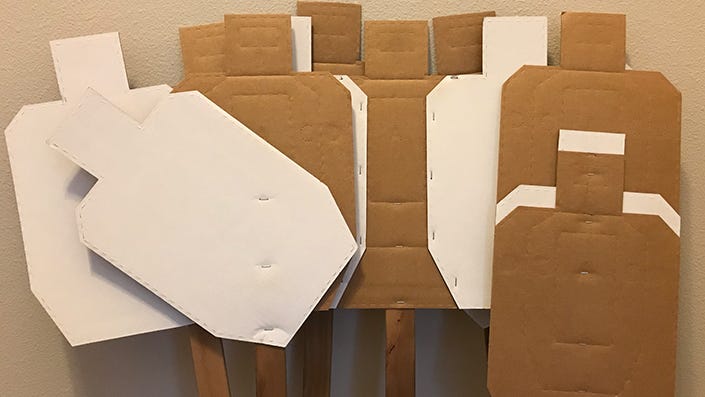Getting the Most Out of Dry Fire
Admit it: Half the fun in competing in shooting events is getting to pull that trigger and hear your gun go bang. For rookies and pros alike, there’s just nothing like ringing steel and the rush that comes with managing recoil and adrenaline.
But what if the best way to take the next step in your competitive shooting was hearing a click instead of a bang?
Most people have heard about dry fire exercises to improve, but we catch up with Tim Ramberg, Captain of the Rainier Arms Shooting Team to do a deep dive into some specifics about how to get the most out of dry fire.
Dummy Rounds

You don’t get to hear the bang, but dry fire can get you the edge you need to improve as a shooter.
How much time do you spend working dry fire and how much working live fire?
Almost immediately after I started competing, I started a dry fire routine 30 minutes a day, every day - work days, holidays, sick days... At the beginning I dry fired literally EVERY day, but now I generally take match and live fire days off. My goal is an hour-long live fire practice session a week. Life’s realities impact that because it can take an hour to get to the range and there’s just not enough daylight year-round. I do get to shoot a three-stage indoor weeknight match almost every week and a local outdoor match most weekends.
Are there some common mistakes you see people making with dry fire?
Consistency! Sort of like those New Year’s fitness resolutions... People will do one day, or a couple days, and expect to see results. It’s better than nothing, but to get great results, more consistency is required. Decide how much improvement you want to see, then find an amount of time you can commit to every day, or every other day. Even 15 minutes a day adds up quick! Just be consistent!
Efficiency! Break your game down into the fundamentals. There is no need to run elaborate stages in practice. Get the fundamentals locked in and you’ll be able to apply them to any challenge a Match Director throws your way. If there is a specific fundamental that is lacking, focus on it until it becomes a strength! Examples: draw, target transition, weapon transition, entry, exit, strong hand, weak hand, etc.
Four Plate Racks

You don’t have to go crazy with elaborate staging. Just work your fundamentals on targets you’re likely to see when you compete.
Honesty! There are lots of sayings about this: “Perfect practice makes perfect,” “You’re only cheating yourself,” etc... I see a lot of videos with people hitting crazy fast par times. Then I see match video and their performance doesn’t remotely match. This doesn’t add up. If you are honest with yourself, you should be able to replicate your fundamentals practiced in dry fire both in live fire and under the clock. Otherwise, ask yourself what was different in dry fire: Was my form perfect? Did I get a great sight picture? Was it an Alpha? Was it 100% repeatable?
I’m going to say something controversial. Prevailing wisdom is to do all your dry fire on the timer against par times.
Don’t! Perhaps you’re more disciplined than me, but I found that using the timer to chase par times resulted in my form breaking down. All that mattered was the rush to beat the buzzer. Without the timer my focus is purely on execution. I often work three different speeds: slow motion (feel the entire movement’s execution perfectly), match speed (perfect execution every time), and all out (execution begins to break down as I push past my limits). At match speed, my ability to execute consistently sets my speed, and the time is purely a reflection of that.
Any tips on setting up dry fire space in a house?
Flexibility! All my dry fire targets are mounted on sticks that can lean up against any wall in the house. This allows me to place them anywhere and easily remove them with no trace. Also! Do those reload drills over a bed or beanbag...no more bending down equals twice the reloads! For a bonus, get some foam blocks to use as fault lines for entry and exit.
Flexible Targets

When it comes to setting up your dry fire station, keep it flexible. Targets like these can go up and down in a hurry.
Favorite Drills?
The basics: draw, target transition, weapon transition, entry, exit, strong hand, weak hand. Sounds simple, but these foundational skills can be applied to every stage I shoot. If I find myself struggling with a specific skill, I will add that to my routine. As an example: A couple years ago I was struggling with offhand rifle. I added it to my dry fire routine and then smoked the offhand rifle portion of the “shoot off” at UML World’s.
4 Examples:
-Offhand Rifle: I started doing this when I noticed my offhand rifle really suffering. It made a huge difference. 4 different distance plate racks, Port Arms start position, crisp sight picture on each plate!
-Reload Series: Want to make GM? You better be able to crush reloads. I go through a “work up” series: slow motion, then full speed to the magwell and stop, then slow motion to magwell and full speed seat, then put it all together!
-Entry: We are always entering shooting positions and most people are losing precious time not getting their first shot off soon enough. While this is working a start position, the footwork applies to all entry. From port arms and low ready, one step entry, then multistep entry.
-Weak Hand: Don’t forget your weak hand…it won’t win you matches but it can lose them. Weak hand port arms, low ready, then transfer without a reload, then transfer with a reload.
Improve your shooting game with Making the Move from Iron Sights to a Red Dot on Your Pistol and Making Sense of Magnified Optics on a Tactical Carbine. Connect with @tim.ramberg

BIO
Tim was introduced to handgun competitions in 2010 and got hooked immediately. In 2014, he shot his first multi-gun match and hasn’t looked back! Tim is a USPSA Grand Master (Open, PCC), Chief Range Officer, UML Pro (Open, 2x4 Open) and local Match Director. Most recently he competed in Vegas at the SureFire UML World Multi-Gun Championship (1st Place - 2x4 Open) and the Vision-X Night Match (1st Place - PCC) in Western Washington where over $20,000 raised for Toys for Tots!
It’s our hope you can learn and laugh along with the expert voices we feature on this blog. We want to be clear that the opinions you see featured here are just that: opinions. The content belongs to the authors and is not necessarily the opinion of Vortex Optics.
To learn more about what you’ve read, please like, follow, and otherwise support our authors.





